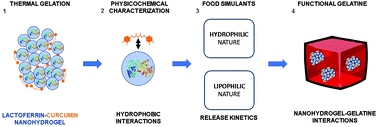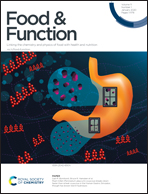Physicochemical characterisation and release behaviour of curcumin-loaded lactoferrin nanohydrogels into food simulants
Abstract
Whey protein nanostructures can be used as vehicles for the incorporation of nutraceuticals (e.g., antioxidants or vitamins) aimed at the development of functional foods, because nanostructures provide greater protection, stability and controlled release to such nutraceuticals. Fundamental knowledge is required regarding the behaviour of nanostructures when associated with nutraceuticals and their interactions with real food matrices. In this study, a lactoferrin (LF) nanohydrogel was developed to encapsulate curcumin (nutraceutical model) and its behaviour was evaluated in terms of the LF structure and the interaction with curcumin. The release kinetics of curcumin from LF nanohydrogels was also assessed using food simulants with a hydrophilic nature (10% ethanol) and lipophilic nature (50% ethanol). This system was able to encapsulate curcumin at 80 μg mL−1 with an efficiency of ca. 90% and loading capacity of ca. 3%. Through spectroscopic characterisation, it is suggested that LF and curcumin bind via hydrophobic interactions and the average binding distance between LF and curcumin was found to be 1.91 nm. Under refrigerated conditions (4 °C), this system showed stability for up to 35 days, while at room temperature (25 °C) it was shown to be stable for up to 14 days of storage. The LF nanohydrogel presented higher release rates of curcumin in a lipophilic food simulant (stable after ca. 7 h) as compared to a hydrophilic simulant (stable after ca. 4 h). LF nanohydrogels were successfully incorporated into a gelatine matrix and showed no degradation in this process. The behaviour of this system and the curcumin release kinetics in food stimulants make the LF nanohydrogel an interesting system to associate with lipophilic nutraceuticals and to incorporate in refrigerated food products of a hydrophilic nature.

- This article is part of the themed collection: 8th International Symposium on Delivery of Functionality in Complex Food Systems (DOF 2019)


 Please wait while we load your content...
Please wait while we load your content...